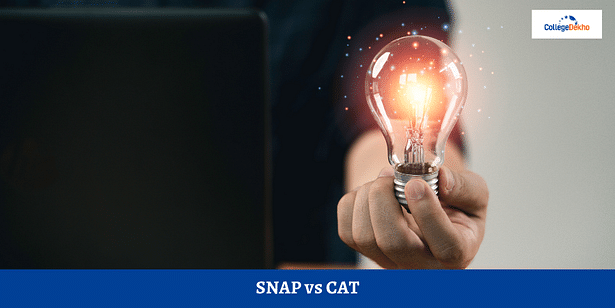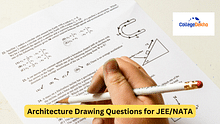
SNAP vs CAT: The SNAP and CAT MBA admission examinations are two of the top MBA entrance exams in India. The CAT exam is generally considered more challenging and competitive than SNAP, as it is a widely recognized entrance exam for prestigious IIMs and other top B-schools. On the other hand, SNAP is conducted only for admission into colleges of Symbiosis International University and is considered less challenging than CAT. While comparing the SNAP and CAT exams, it is imperative to consider a multifaceted approach that goes beyond mere difficulty levels. The perceived challenge of these assessments is all the more apparent due to factors like test content, formats, difficulty levels, and specific strengths and weaknesses.
It is an often posed question if SNAP or CAT is more difficult to clear and gain admission to good Indian colleges. The 16 SIU-associated colleges in India accept SNAP exam scores, whereas, the IIMs and several other B-Schools in India accept the CAT. In this article, we go over a few details on how the two of them differ in certain areas. Let's take a look at the detailed comparison between SNAP and CAT mentioned below!
Also Read: CAT vs CMAT, NMAT, XAT, SNAP & Other MBA Entrance ExamsSNAP vs CAT: Major Highlights
There are several differences between the SNAP and CAT exams in terms of exam pattern, syllabus, marking scheme and other aspects. Let’s take a look at some of the major differences between the two entrance exams mentioned in the table below:
Particulars | SNAP Exam | CAT Exam |
|---|---|---|
Full form | Symbiosis National Aptitude Test | Common Admission Test |
Conducting Body | Symbiosis International (Deemed) University | Indian Institutes of Management (on a rotational basis) |
Eligibility | The candidate must have completed Graduation with a minimum 50% aggregate (45 % for SC/ST/PwD candidates) | The candidate must have completed Graduation with a minimum 50% aggregate (45 % for SC/ST/PwD candidates) |
Sections | 3 | 3 |
Exam mode | Online | Online |
Exam Duration | 60 minutes | 120 minutes |
Difficulty level | Moderate to Difficult | Difficult |
Exam Fee | INR 2,250 for all candidates + INR 1000 (per SIU institute) | INR 2,400 for General and OBC candidates and INR 1,200 for Reserved category candidates |
Official Website | snaptest.org | iimcat.ac.in |
SNAP Exam Pattern vs CAT Exam Pattern
The first two important dimensions that need to be considered while differentiating between two exams are the exam pattern and syllabus. Both of them form the basis of any given exam. Here is the exam pattern for both CAT and SNAP:
Particulars | SNAP | CAT |
|---|---|---|
Number of Sections | 3
| 3
|
Sectional Time | None |
|
Number of Questions | 60 | 66 |
Duration of Examination | 60 mins | 120 mins |
Negative Marking | -0.25 for each incorrect response | 1 for MCQ-type questions 0 for Non-MCQ type questions |
Difficulty Level | Easy to Moderate | Moderate to Difficult |
| Learn More | SNAP Exam Pattern | CAT Exam Pattern |
Also Read:How to Approach SNAP Question Paper?
SNAP vs CAT: Syllabus
The syllabus of both CAT and SNAP is more or less the same having Quant, Verbal Ability, and Data Interpretation and logical Reasoning. For CAT and SNAP, you need to study the following subjects:
Subject | SNAP | CAT |
|---|---|---|
English |
|
|
Quantitative Ability |
|
|
Data Interpretation |
|
|
Analytical and Logical Reasoning |
|
|
| Learn More | SNAP Syllabus | CAT Syllabus |
Also Read: Top MBA Colleges Accepting SNAP Scores
SNAP vs CAT: Selection Process
SNAP Exam
SNAP is a university entrance exam conducted by the Symbiosis International Deemed University for admission to various courses of study offered by its affiliated universities. The SNAP selection process is based on three stages:
- SNAP score
- Group Exercise (GE)
- Personal Interaction (PI)
Particulars | Weightage for Final Merit List (in %) | |
SNAP Score (out of 60, scaled down to 50 marks) | 50 | |
Personal Interaction(PI) | 40 | |
Group Exercise (GE) | 10 | |
Total | 100 | |
CAT Exam
To qualify for an MBA course and other graduate management courses at the Indian Institutes of Management (IIMs) and other top business schools like JBIMS, PUMBA, etc, the CAT score is the most important criterion. However, apart from that, one must also make sure to clear the rest of the rounds of the IIM CAP 2024 or the CAT selection process. The CAT selection process generally involves the following stages:
- CAT Score
- Written Ability Test
- Group Discussion/Personal Interview
CAT Parameters | Weightage |
|---|---|
CAT Score | 25% |
Group Discussion (GD)/ Personal Interview (PI) | 30% |
Written Ability Test (WAT) | 10% |
Class 10 Academic Records | 10% |
Class 12 Marks Academic Records | 5% |
Graduation Academic Records | 10% |
Weighted Work Experience | 10% |
Total | 100% |
Key Differences Between CAT and SNAP
Apart from the differences between the exam pattern, syllabus, and selection process of SNAP and CAT, the two fair different in other aspects as well. Given below is a list of differences we can see between the CAT and the SNAP examination:
SNAP vs CAT: Conducting Body
Symbiosis International (Deemed University) conducts the SNAP exam once every year in a Computer Based Test (CBT) mode at various test centers across India. On the other hand, one of the IIMs organizes the CAT exam on a rotational basis for admission to MBA or Post Graduate Programme in Management (PGPM) courses.SNAP vs CAT: Difficulty Level
As previously said, CAT is more difficult than SNAP. This means that even if you have scored fairly well on the SNAP, achieving the same might not be possible on the CAT exam. SNAP assesses your ability to solve issues quickly and accurately rather than your technique for doing so (which is seen in CAT).
SNAP vs CAT: Types of Questions
There's a lot of similarity between the CAT and SNAP syllabi. The SNAP exam, on the one hand, consists entirely of multiple-choice questions. CAT, on the other hand, includes both MCQs and non-MCQs. TITA-style questions are non-MCQs in which candidates must Type In The Answer (TITA). The questions in the MCQ category account for 80% of CAT types, with only 20% TITA-type questions.
SNAP vs CAT: Marking Scheme
One point is awarded for each right answer in the SNAP question, but three points are awarded for a proper answer in the CAT question. For every wrong response in the CAT, one mark is deducted. However, in SNAP, there is a negative grading of -0.25 for any question answered incorrectly.
SNAP Marking Scheme | CAT Marking Scheme |
|---|---|
+1 for each correct answer | +3 marks for each correct answer |
-1/4 marks for each incorrect answer | -1 mark for each incorrect answer |
SNAP vs CAT: Application Fees
The application fee for SNAP registration for most candidates is INR 2250 whereas the application fee for the CAT exam is INR 2400 For General and NC-OBC candidates and for SC, ST, and PwD candidates, it is INR 1200.
SNAP vs CAT: Duration of Exam
The duration of the SNAP Exam is 60 minutes and In the SNAP Exam there is no sectional time limit whereas The duration of the CAT 2024 is 120 minutes and there is a sectional limit i.e. 40 minutes is allotted to each section.
SNAP vs CAT: Acceptance by B schools
When it comes to acceptance by B-schools, CAT wins the race. While SNAP is only accepted by 16 Symbiosis Institutes, CAT scores are accepted not only by IIMs but also by every other management school across India.
SNAP vs CAT: Preparation
The methods of preparation used by candidates when preparing for either of these exams are very different even though the syllabus for both these exams have a certain degree of similarity. Since the marking scheme of these exams has a big difference, candidates have to adjust their approach based on which exam they are appearing for, SNAP or CAT. Candidates can take a look at the preparation techniques for each section of SNAP and CAT mentioned below:
SNAP Exam Preparation
Take a look at the preparation and exam tips for each section of the SNAP exam mentioned below:
SNAP Exam Sections | How to Prepare |
|---|---|
General English | Both verbal ability and reading comprehension are a part of the General English section of SNAP. This section usually takes a considerable amount of exam time due to aspirants facing trouble understanding long reading passages. Grammar and vocabulary-related questions are frequently included in the verbal ability portion of this section. Aspirants must remain focused on the fundamentals take regular SNAP mock tests and improve their reading speed by reading comprehension passages daily. |
Quantitative Ability: Data Interpretation & Data Sufficiency | The Quantitative Ability section of SNAP comprises quantitative ability, data interpretation, and data sufficiency and is focused on assessing a candidate's mathematical skills. To perform well in this section, aspirants focus on fundamental mathematical concepts such as geometry, mensuration, and algebra. Practicing SNAP previous year papers and sample questions are crucial to improve performance in this section |
Analytical & Logical Reasoning | The Analytical and Logical Reasoning section of SNAP is aimed at assessing a candidate's analytical and logical thinking. Questions like puzzles, number sequences, coding and decoding, blood relations, nonverbal thinking, etc. are included in this section. The ideal approach to this section is choosing the right questions and answering them with remarkable accuracy. |
CAT Exam Preparation
Check out the best preparation and exam tips for every section of the CAT exam below:
CAT Exam Sections | How to Prepare |
|---|---|
Verbal Ability and Reading Comprehension | The Verbal Ability and Reading Comprehension section of CAT is by far the lengthiest section of the exam. Candidates must make sure they do not spend too much time on the Reading comprehension portion of the test and answer only those questions that they can answer accurately. Enhancing vocabulary and grammar is crucial for effectively completing this section since fill in the blanks, para jumbles, missing words, one-word substitution, and generic grammar are common topics of this section. |
Data Interpretation and Logical Reasoning | Data Interpretation and Logical Reasoning is one of the toughest sections of CAT and requires a tremendous amount of practice during preparation to effectively crack this section. Candidates must practice mock tests and sample question papers rigorously to get a grip on the type of questions asked in this section which include number series, puzzles, blood relations, tables, graphs, caselets, etc. Candidates have to improve their problem solving skills to score well in this section. |
Quantitative Aptitude | The Quantitative Aptitude section is based on basic mathematical concepts that are taught to students in high school. However, candidates need to have a strong foundation in mathematics to perform well in this section. Candidates must practice NCERT problems to understand the concepts tested in this section of CAT. Since this section usually involves heavy calculations, aspirants must get comfortable with mental maths and complex calculations without the aid of a calculator. Some of the common topics in this section include Algebra, Geometry, Proft & Loss, Mensuration, Indices, Linear Equations, etc. |
SNAP vs CAT: Level of Competition
Both SNAP and CAT are popular MBA entrance exams in India and both these exams have lakhs of applicants every year. However, the CAT exam has a significantly higher level of competition when it comes to the MBA admission process simply due to the number of applicants that apply for the CAT each year. Last year, the CAT exam had 2.88 lakh applicants whereas the SNAP exam had 1.4 lakh applicants.
One of the reasons why the CAT exam has so many applicants each year is the wide acceptance of the CAT result among B-schools in India. The CAT exam is accepted by over 1300 MBA colleges across the country. On the other hand, SNAP is accepted by colleges affiliated with Symbiosis International University and 20 other private MBA institutes. Therefore, candidates prefer the CAT exam over SNAP as it helps them have more options when applying for MBA colleges for admission.
Top Colleges Accepting SNAP and CAT Exams
One of the biggest differences between SNAP and CAT is the acceptance of each exam score among B-schools. Since the aim of aspirants for appearing for either of these exams is to secure MBA admission to some of the top-ranked MBA colleges in India, the acceptance of either SNAP or CAT makes a huge difference in terms of which exam is chosen by a management aspirant. Take a look at the top colleges accepting SNAP and CAT mentioned in the table below:
MBA Colleges Accepting SNAP Scores | MBA Colleges Accepting CAT Scores |
|---|---|
Symbiosis Institute of Computer Studies & Research (SICSR), Pune | |
Symbiosis Centre for Management and Human Resource Development (SCMHRD), Pune | |
Symbiosis Institute of Business Management (SIBM), Bengaluru | |
IIM Mumbai (Previously NITIE) | |
Symbiosis Institute of Business Management (SIBM), Hyderabad | IIM Visakhapatnam |
| Management Development Institute (MDI) Gurgaon | |
| S.P. Jain Institute of Management and Research (SPJIMR) Mumbai | |
Symbiosis School of Sports Science (SSSS), Pune | International Management Institute (IMI) New Delhi |
| Faculty of Management Studies, University of Delhi (FMS) New Delhi | |
| Xavier Institute of Management Bhubaneswar (XIMB) Bhubaneswar | |
| Institute of Management Technology (IMT) Ghaziabad | |
Symbiosis Institute of Business Management (SIBM), Nagpur | |
Prin LN Welingkar Institute of Management Development and Research Mumbai |
Determining which exam is tougher depends on your strengths, weaknesses, and personal preferences. If you are good at math, and you are comfortable with complex problem-solving, you will find that CAT is more challenging but more rewarding. If you have a good knowledge of general English and an expanded set of questions, SNAP might be easier to understand.
Related Links:
We hope the above article was helpful in providing useful information pertaining to the SNAP vs CAT analysis. For any further queries, drop your question in the CollegeDekho QnA Section or call us at 1800-572-9877.

















Similar Articles
Christ University BBA Admissions 2024: Registration (Started), Exam Dates (Out), Pattern, Syllabus, Admit Card
XAT Score vs Percentile 2024: Official Cut off, Score Predictor
Top MBA Entrance Exams 2024 in India: Dates, Registration, Top Colleges
MBA Admission 2024 (Open): Application Dates, Entrance Exams, Admission Process & Top Colleges
List of Top 10 MBA Specialisations in 2024: Choose the Best One
CMAT Important Topics 2024 - Section-wise Weightage